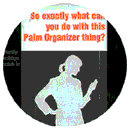"Women writers have always tried to steal the language... throughout most of her history, the woman writer has had to state her self definitions in code form, disguising passion as piety, rebellion as obedience. Dickenson’s ‘Tell all the Truth but tell it slant’ speaks for (women) writers who in every century have been inhibited both by economic dependence and by the knowledge that true writer signifies assertion while true woman signifies submission." {41}
Alicia Ostriker
The Thieves of Language: Women Poets and Revisionist Myth-making
7. Inquire
So much of our thinking about technology is magical thinking. We imagine that it will transform our lives. It will make our lives better, easier, faster. By liberating us from the toil of the past, we will be elevated from cindergirl to matriarch in a Flash (TM). Digital design-workers are seduced by this same fantasy. Art Schools, Universities and Tech Colleges around the country are overflowing with young wanna-be graphic designers. Their fingers itch to get on the latest hardware and software that promises to fulfill their dreams, (or at least the dreams of their parents).

Little progress has been made toward regulating the work conditions in these rosy-hued jobs. The anecdotes are many. Digital designers work long hours. Some report 60-80 hour work weeks. New physical maladies plague this work force with eye strain, neck aches, and Carpal Tunnel Syndrome. Job satisfaction varies, but it was recently noted that 5 years after their entry into the design work force a surprising percentage of graphic designers were no longer in the field. Digital designers must consider their working conditions as laborers in cyberspace. If they choose to alter their status conventionally, by working their way up the food pyramid to become...project manager, art director, information architect, design professor....how will they monitor the work conditions of those beneath them?
I know of no union for digital designers.
The conundrum for the designer, is that this authority figure is ultimately her client. She needs the money (fire) that she has come to receive from this client, in exchange for the tasks she accomplishes. There are certain secrets and stories which she is not sanctioned to ask of this client. When performing the task of creating positive PR for a giant energy conglomerate, she may not inquire about the secret stock dumping that this client is hiding from public view. She serves this powerful master by asking only the questions that the Yaga deems appropriate. The designer is the good little girl, knows well how and when to hold her tongue. This is the arrangement. This is the voluntary submission to the designer / client relationship.
Fairy tales have been around long enough to have already weathered the translation, the remediation, from one distribution method to another, many times. Their wisdom, if you could call it that, is anything but pure. It has been duplicated, mistranslated and subverted. When I began this project, I knew that fairy tales had mutated, but I had no idea how much. My personal image bank included childhood exposure to fairy tales from the Grimms’ collection, animated adaptations by Disney, and the parodically “fractured fairy tales” on Jay Ward’s Rocky and Bullwinkle Show. As a young woman I encountered Anne Sexton’s radical revisions of traditional tales in her book of poetry, Transformations. The critical work of Jack Zipes has illuminated for me the multivalence of wonder tales, and their social uses. Fairy tales, it seems, were always about transformation. Within the tale, magic worked wonders and the protagonist’s destiny was transformed. At the same time, the storyteller exerted pressure on the external container of the tale, morphing both its form and content.
YOU'VE GOT MAIL!
Subject: Re: Your "junk" is not junk!
Date: Mon, 12 Mar 2001 11:50:43 -0600 (Central Standard Time)
From: Robyn Roslak
I wondered about how fairy tales had changed when they were lifted from the oral tradition into literary formats. I wondered how the format might shape the narrative. I also questioned if the web might take us backward and forward at once, to the world of oral storytelling, as the audience for the tale gained more opportunities to alter and redistribute these digital stories among their own network of friends and family.
Would the nature of digital technology and the web provide a forum for untold stories to be told?
Would increased agency transform the audience into author by inviting them to join in construction of the text?
Alicia Ostriker
The Thieves of Language: Women Poets and Revisionist Myth-making
